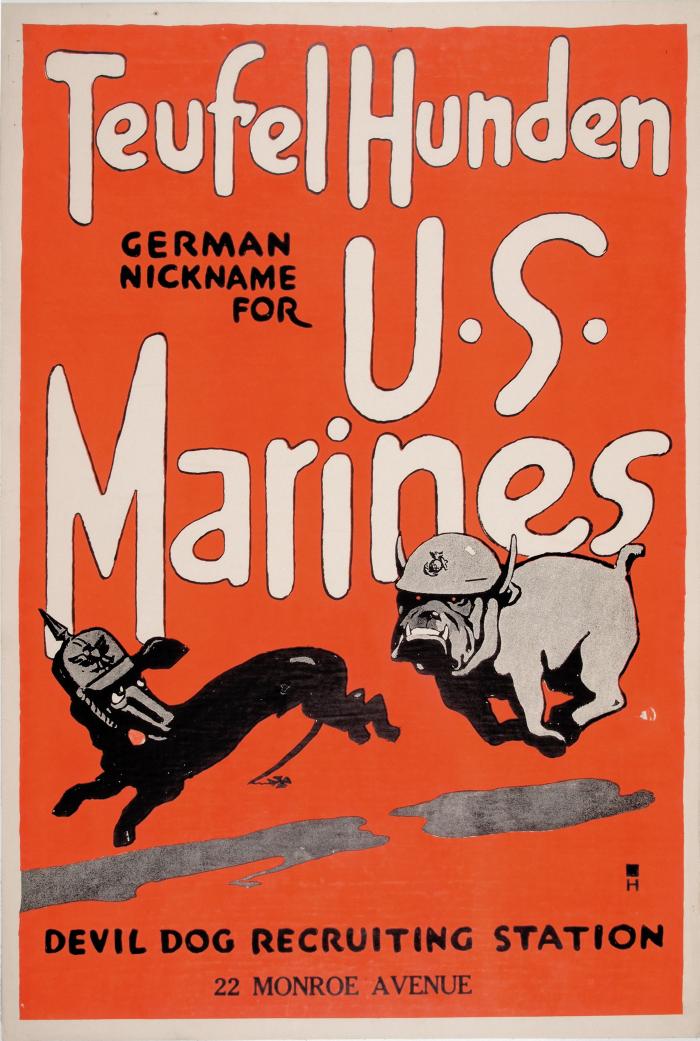Comments and Tags
Be the first to comment on this item!
Posters
Military and Veterans ➔ Poster, Teufel Hunden, German Nickname for U. S. Marines
Identifier:
136627.4Description:
Teufel HundenGerman Nickname for U. S. Marines
Devil Dog Recruiting Station
22 Monroe Avenue
“Teufel Hunden, German Nickname for U.S. Marines” by Charles B. Falls was a poster used in 1918 to encourage men to enlist in the U.S. Marines. The German “Teufel Hunden” means “Devil Dogs,” and the English-language version of the nickname is still used today. The term supposedly originated from German soldiers who witnessed the ferocity and tenaciousness of American Marines at Belleau Wood in France. After twenty days of fighting and 5,200 American casualties, U.S. Major General Omar Bundy’s troops succeeded in defeating the German 461st infantry regiment. The battle served as excellent publicity for the U.S. Marine Corps among Americans and the French. The poster draws on a sense of patriotism in American military prowess in order to encourage new recruits. It depicts the marines as a bulldog and the Germans as a fearful daschund. Americans would have been proud that their marines were feared as “Devil Dogs.” However, it is unlikely that the Germans actually used this nickname for the marines. First, the idea that Germans called American marines “Teufel Hunden” appeared in a Marine Corps magazine two months before the Battle of Belleau Wood. Second, “Teufel Hunden” was an obscure German term, and was not grammatically correct. It would have been written “Teufelshunde,” suggesting that a native German-speaker did not invent this. Thus, this poster is probably an example of fabrication used as propaganda.
Date:
circa 1917Materials:
PaperDimensions:
28.25" h 19" wCurrent Location Status:
In StorageSource:
Museum CollectionExhibit/Program:
I Want You - World War One Posters (July 1 2014 – December 21 2015)The years 1914-1918 mark the centenary of World War I, the most devastating global war in history. In the United States alone, over 4,000,000 military personnel were mobilized with 110,000 deaths. Virtually everyone was affected by the war in some way. In recognition of this important event in history, GRPM has selected posters from its permanent collection that demonstrate important issues at the heart of the war efforts.
Posters were a central way for the government to communicate with the public during World War I. The major themes of the posters were: patriotism and justifying the war, the recruitment of men and women for military and labor forces, raising money and resources as well as managing standards of behavior during a time when life was highly unpredictable. Through creative and symbolic graphics with bold messages, posters were considered a force in gaining support and uniting the public in the wartime efforts.
As you view these posters, reflect on the methods employed in creating them. How do the fonts, the word choice and images reinforce the intended message? Do these posters evoke a mood or emotion? Do any of the ideas in these posters conflict with the social and cultural norms of the time?
Related Entities:
United States Marine Corps (is related to)Alternate names: Continental Marines, USMC
The United States Marine Corps, also known as USMC, is a service branch of the United States Armed Forces specializing in amphibious and expeditionary warfare. The USMC is responsible for operating installations on land and amphibious warfare ships around the world. It was founded as the Continental Marines in 1775, during the American Revolutionary War. After the war, the marines disbanded due to lack of funding. On July 11th, 1798 the institution was reestablished by the United States Congress. On June 30th, 1834 it became an asset of the United States Department of the Navy. The USMC is the smallest service branch of the Department of Defense, working closely alongside the United States Navy on several tactical aviation squadrons throughout the world. In addition, they also operate from inside many Navy aircraft carriers serving as a valuable asset both at sea and on land. Charles B. Falls (creator)

